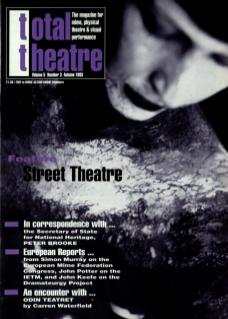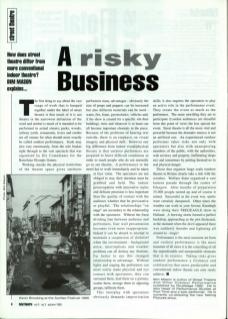The first thing to say about the vast range of work that is lumped together under the label of street theatre is that much of it is not theatre in the narrowest definition of the word, and neither is much of it intended to be performed in actual streets: parks, woods, railway yards, restaurants, rivers and castles are all venues for what should more exactly be called outdoor performance. Scale may also vary enormously, from the solo busker right through to the vast spectacle that was organised by Els Comediants for the Barcelona Olympic Games.
Working outside the physical restrictions of the theatre space gives outdoors performers many advantages – obviously the size of props and puppets can be increased but also different materials can be used – water, fire, foam, pyrotechnics, vehicles, and if the show is created for a specific site then buildings, trees and whatever is to hand can all become important elements in the piece. Because of the problems of hearing text outside, there is an emphasis on visual imagery and physical skill. However, one big difference from indoor visual/physical theatre is that outdoor performers are prepared to brave difficult conditions in order to reach people who do not normally go to see theatre. A performance in the street has to work immediately and be taken at face value. The spectators are not obliged to stay, their attention must be grabbed and held. The indoor preoccupation with innovative styles and delicate precision is less important than the quality of contact with the audience whether that be provocative or playful. The relationships ‘on stage’ are secondary to the relationship with the spectators. Without the fixed dividing line between audience and performers, four wall presentation becomes even more inappropriate. Indeed it can be absurd to attempt to maintain a suspension of disbelief when the environment – background noise, interruptions and weather problems – can all destroy any illusions. Far better to use this changed relationship to advantage. Without lights and staging the performers can more easily make physical and eye contact with spectators, they can surround them, lead them on a journey, scatter them, arrange them in opposing groups, infiltrate them.
This interplay with spectators obviously demands improvisation skills; it also requires the spectators to play an active role in the performance event. They create the event as much as the performers. The more unwilling they are to participate (London audiences are dreadful from this point of view) the less special the event. Street theatre is all the more vital and powerful because the dramatic tension is not an artificial one. An experienced outdoor performer takes risks not only with spectators but also with unsuspecting members of the public, with the authorities, with territory and property (infiltrating shops, etc), and sometimes by putting themselves in real physical danger.
Those that organise large scale outdoor theatre in Britain clearly take a risk with the weather. Welfare State organised a vast lantern parade through the centre of Glasgow. After months of preparation 35,000 people turned up and of course it rained. Successful as the event was, spirits were certainly dampened. Other times the weather can work in your favour: Kneehigh were doing their Tregeagle show in Holland. A brewing storm formed a perfect backdrop, approaching as the plot thickened. At the moment when the devil appeared there was suddenly thunder and lightning all around us – magic!
Performance is the most transient artform and outdoor performance is the most transient of all, since it is the coinciding of all the unpredictable and unrepeatable elements that is its essence. Taking risks gives outdoor performance a freshness and exhilaration that more predictable and conventional indoor theatre can only rarely achieve.
Bim Mason is author of Street Theatre And Other Outdoor Performance, published by Routledge 1992. He is also Head of Performance Studies at Fool Time and a solo performer. He is currently co-directing the new Talking Pictures show.

